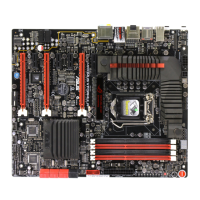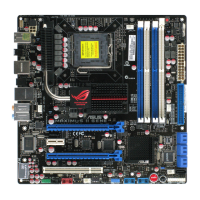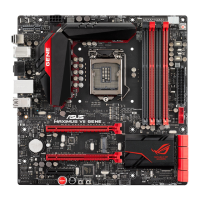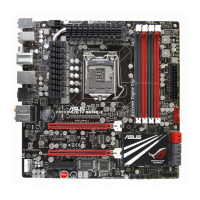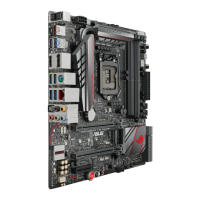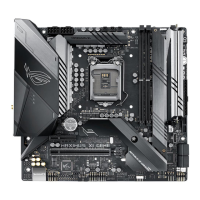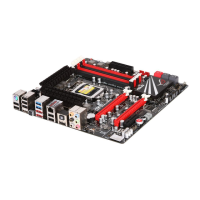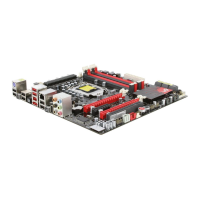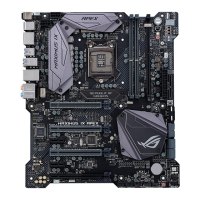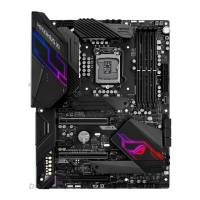Do you have a question about the Asus Maximus V GENE and is the answer not in the manual?
General welcome message for the motherboard.
Lists all items included in the motherboard package.
Highlights key technologies and features of the motherboard.
Details the main product highlights and specifications.
Explains specific features designed for gaming.
Describes features for performance tuning and overclocking.
Lists and explains ASUS-specific motherboard features.
Details the software utilities included with the motherboard.
Provides essential precautions before hardware installation.
Introduces the motherboard components and layout.
Visual guide to the physical layout of motherboard components.
Detailed list of connectors, jumpers, and slots on the board.
Guides users through the process of assembling a PC.
Lists necessary tools and components for PC assembly.
Step-by-step instructions for installing the CPU.
Instructions for installing the CPU cooler assembly.
Step-by-step guide for installing system memory modules.
Instructions on how to mount the motherboard in the PC case.
Details on connecting the ATX power supply to the motherboard.
Instructions for connecting SATA storage devices.
Guide for connecting front panel case connectors.
Instructions for installing expansion cards like GPUs.
Guide for installing the mPCIe Combo card.
Identifies and explains the motherboard's rear I/O ports.
Explains the audio ports and their connections.
Steps for the initial system startup after assembly.
Introduction to the BIOS and its purpose.
How to enter and navigate the BIOS setup utility.
Overview of the advanced BIOS configuration mode.
Overview of the simplified BIOS configuration mode.
Settings for CPU overclocking and performance tuning.
Basic system information and settings in BIOS.
Options for setting BIOS administrator and user passwords.
Access to detailed system configuration settings.
Settings related to the CPU and its features.
Controls for SATA device modes (AHCI, RAID).
Settings for USB controller and device support.
Enables or disables integrated motherboard devices.
Displays system temperatures, voltages, and fan speeds.
Configures system boot order and options.
Access to special function utilities.
Utility for updating the motherboard BIOS.
Options for saving or discarding BIOS changes and exiting.
Comprehensive guide to updating the system BIOS.
Windows-based utility for BIOS management and updates.
BIOS updating utility using a USB flash drive.
Tool for recovering corrupted BIOS files.
Method for updating BIOS via USB drive under standby power.
Guide for installing compatible operating systems.
Overview of software utilities provided on the support DVD.
Integrated suite for system tuning and monitoring.
Utility for CPU overclocking and voltage adjustments.
Tool for adjusting VRM voltage and frequency modulation.
Utility for optimizing energy efficiency and power saving.
Utility for monitoring system vitals like temps and voltages.
Displays system sensor data and CPU frequency.
Utility for updating the motherboard BIOS.
Settings for managing the onboard audio features.
Information on setting up SATA RAID arrays.
Steps for installing SATA hard drives for RAID.
How to configure SATA mode to RAID in BIOS.
Overview of Intel technologies for system responsiveness.
Guide for installing SSD caching for performance.
Technology for faster system resume from sleep.
Steps to create a floppy disk with RAID drivers.
Information on ATI CrossFireX multi-GPU technology.
Prerequisites for using ATI CrossFireX technology.
Instructions for installing dual ATI graphics cards.
Information on NVIDIA SLI multi-GPU technology.
Prerequisites for using NVIDIA SLI technology.
Instructions for installing dual NVIDIA graphics cards.
Technology for optimizing graphics performance with multiple GPUs.
Steps to install the LucidLogix Virtu MVP software.
How to configure display modes for Virtu MVP.
Detailed configuration of Virtu MVP features.
Regulatory and compliance statements for the product.
Statement regarding compliance with FCC regulations.
Statement regarding compliance with Canadian regulations.
Notices related to radio frequency equipment usage.
Formal declaration of product conformity to standards.
FCC specific declaration of product conformity.
| ECC | No |
|---|---|
| Non-ECC | Yes |
| Memory voltage | 1.5 V |
| Memory channels | Dual-channel |
| Memory slots type | DIMM |
| Number of memory slots | 4 |
| Supported memory types | DDR3-SDRAM |
| Maximum internal memory | 32 GB |
| Supported memory clock speeds | 1066, 1333, 1600, 1866, 2133, 2600, 2800 MHz |
| Supported memory module capacities | 16GB, 1GB, 2GB, 4GB, 8GB |
| System bus rate | 5 GT/s |
| Processor socket | LGA 1155 (Socket H2) |
| Processor manufacturer | Intel |
| Compatible processor series | Intel Core i3, Intel Core i5, Intel Core i7 |
| Maximum number of SMP processors | 1 |
| USB 2.0 connectors | 2 |
| Number of Parallel ATA connectors | 0 |
| HDMI version | 1.4 |
| Headphone outputs | 6 |
| USB 2.0 ports quantity | USB 2.0 ports have a data transmission speed of 480 Mbps, and are backwards compatible with USB 1.1 ports. You can connect all kinds of peripheral devices to them. |
| Cooling type | Passive |
| Component for | PC |
| Power source type | ATX |
| Motherboard chipset | Intel Z77 |
| PC health monitoring | CPU, FAN, LED, Temperature |
| Audio output channels | 7.1 channels |
| Motherboard form factor | micro ATX |
| RAID levels | 0, 1, 5, 10 |
| Supported storage drive interfaces | SATA II, SATA III |
| Graphics card | HD Graphics |
| OpenGL version | 3.2 |
| DirectX version | 11 |
| Maximum resolution | 2560 x 1600 pixels |
| Maximum graphics card memory | 1696 MB |
| Parallel processing technology support | 2-Way CrossFireX, 2-Way SLI, LucidLogix Virtu |
| PCI Express slots version | 2.0, 3.0 |
| PCI Express configurations | 1x16, 2x8 |
| Controller 2nd interface type | ASMedia PCIe SATA |
| Cables included | SATA |
| LAN controller | Vitesse VSC8601 |
| Wi-Fi standards | Not supported |
| Networking features | Gigabit LAN |
| Ethernet interface type | Gigabit Ethernet |
| BIOS type | EFI AMI |
| ACPI version | 2.0 |
| BIOS memory size | 64 Mbit |
| Width | 244 mm |
|---|
